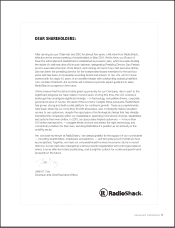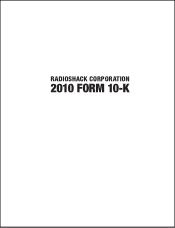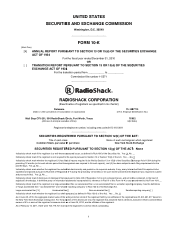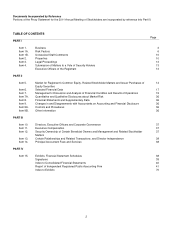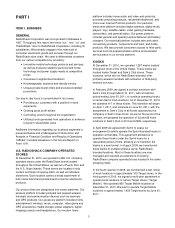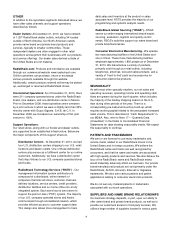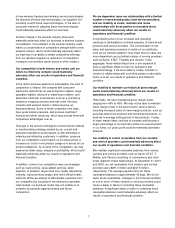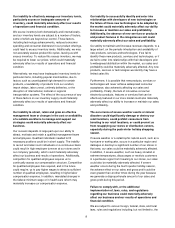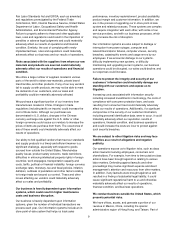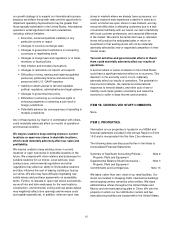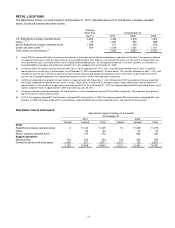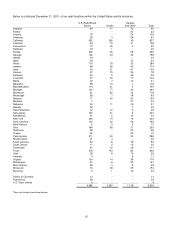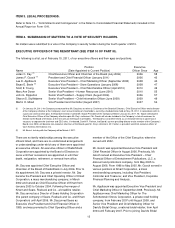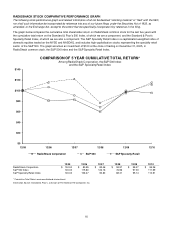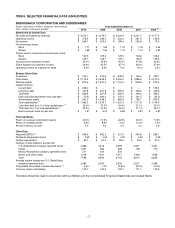Radio Shack 2010 Annual Report Download - page 17
Download and view the complete annual report
Please find page 17 of the 2010 Radio Shack annual report below. You can navigate through the pages in the report by either clicking on the pages listed below, or by using the keyword search tool below to find specific information within the annual report.7
of new wireless handset and wireless service technologies,
the absence of these new technologies, our suppliers not
providing us with these new technologies, or the lack of
consumer interest in adopting these new technologies,
could materially adversely affect our business.
Another change in the wireless industry that could
materially adversely affect our business is wireless industry
consolidation. Consolidation in the wireless industry could
lead to a concentration of competitive strength within a few
wireless carriers, which could materially adversely affect
our business if our ability to obtain competitive offerings
from our wireless suppliers is reduced or if competition
increases from wireless carrier stores or other retailers.
Our competition is both intense and varied, and our
failure to effectively compete could materially
adversely affect our results of operations and financial
condition.
In the retail consumer electronics marketplace, the level of
competition is intense. We compete with consumer
electronics retail stores as well as big-box retailers, large
specialty retailers, discount or warehouse retailers, and
alternative channels of distribution such as e-commerce,
telephone shopping services and mail order. We also
compete with wireless carriers’ retail presence, as
discussed above. Some of these competitors are large,
have great market presence, and possess significant
financial and other resources, which may provide them with
competitive advantages over us.
Changes in the amount and degree of promotional intensity
or merchandising strategy exerted by our current and
potential competitors could present us with difficulties in
retaining and attracting customers. In addition, pressure
from our competitors could require us to reduce prices or
increase our costs in one product category or across all our
product categories. As a result of this competition, we may
experience lower sales, margins or profitability, which could
materially adversely affect our results of operations and
financial condition.
In addition, some of our competitors may use strategies
such as lower pricing, value-added services, wider
selection of products, larger store size, higher advertising
intensity, improved store design, and more efficient sales
methods. While we attempt to differentiate ourselves from
our competitors by focusing on the electronics specialty
retail market, our business model may not enable us to
compete successfully against existing and future
competitors.
We are dependent upon our relationships with a limited
number of name brand product and service providers,
and our inability to create, maintain and renew
relationships with these parties on favorable terms
could materially adversely affect our results of
operations and financial condition.
A significant portion of our net sales and operating
revenues is attributable to a limited selection of name brand
products and service providers. The concentration of net
sales and operating revenues in certain of our platforms,
such as our wireless platform, may mean that our sales are
more dependent upon a limited number of service providers
such as Sprint, AT&T, T-Mobile and Verizon. In the
aggregate, these relationships have or are expected to
have a significant effect on both our operations and
financial strategy. If we are unable to create, maintain or
renew our relationships with such third parties on favorable
terms or at all, our results of operations and financial
condition.
Our inability to maintain our historical gross margin
levels could materially adversely affect our results of
operations and financial condition.
Historically, we have maintained gross margin levels
ranging from 45% to 48%. We may not be able to maintain
these margin levels in the future due to various factors,
including increased sales of lower margin products, such as
personal electronics products and name brand products, or
declines in average selling prices of key products. If sales
of lower margin items continue to increase and become a
larger percentage of our business without an overall growth
in our sales, our gross profit could be materially adversely
affected.
Our inability to collect receivables from our vendors
and service providers could materially adversely affect
our results of operations and financial condition.
We maintain significant receivable balances from various
vendors and service providers such as Sprint, AT&T, T-
Mobile, and Verizon consisting of commissions and other
funds related to these relationships. At December 31, 2010
and 2009, our net receivables from vendors and service
providers were $291.0 million and $247.5 million,
respectively. The average payment term for these
receivable balances is approximately 45 days. We do not
factor these receivables. Changes in the financial condition
of one or more of these vendors or service providers could
cause a delay or failure in collecting these receivable
balances. A significant delay or failure in collecting these
receivable balances could materially adversely affect our
results of operations and financial condition.


